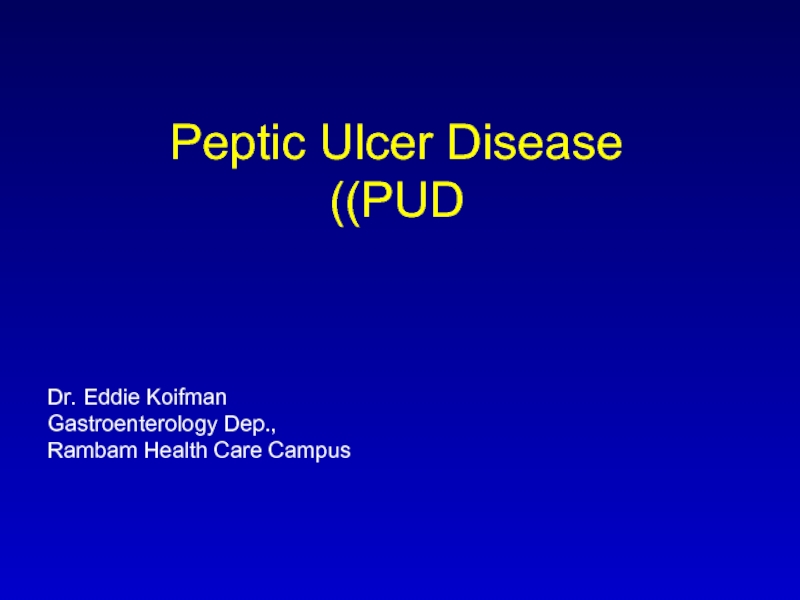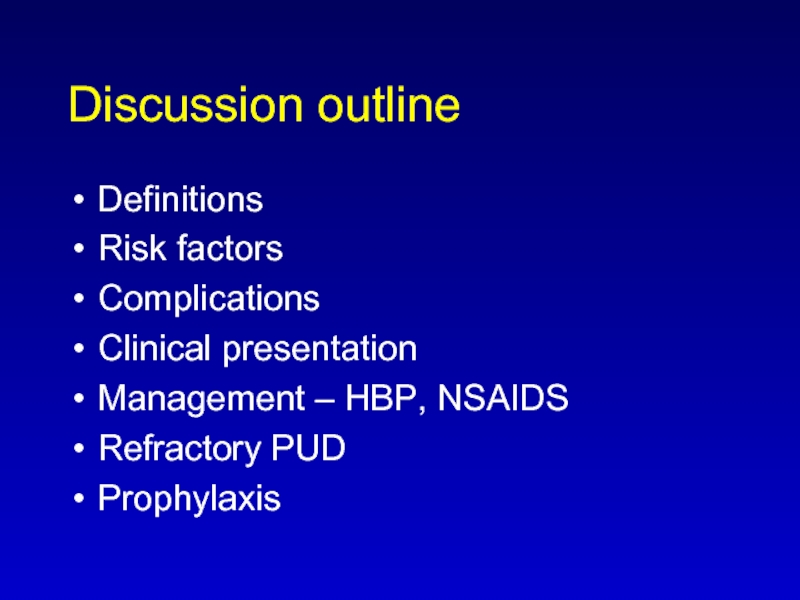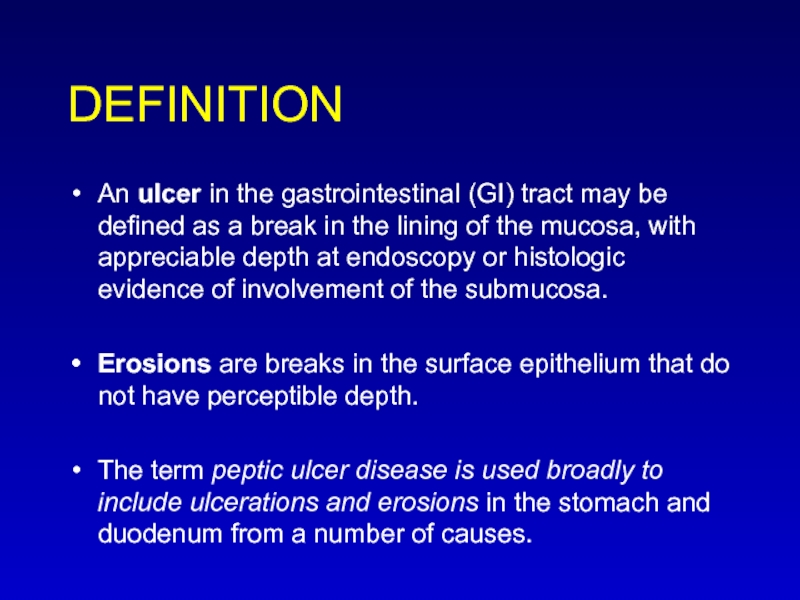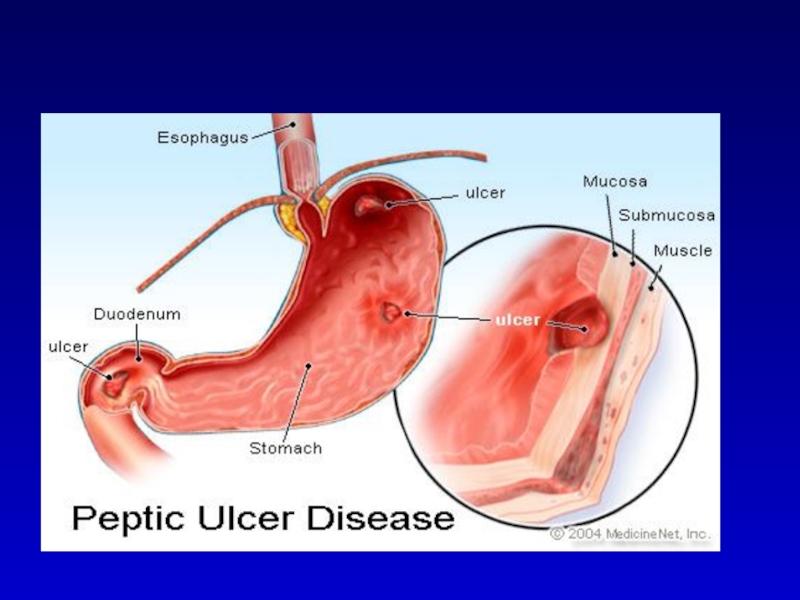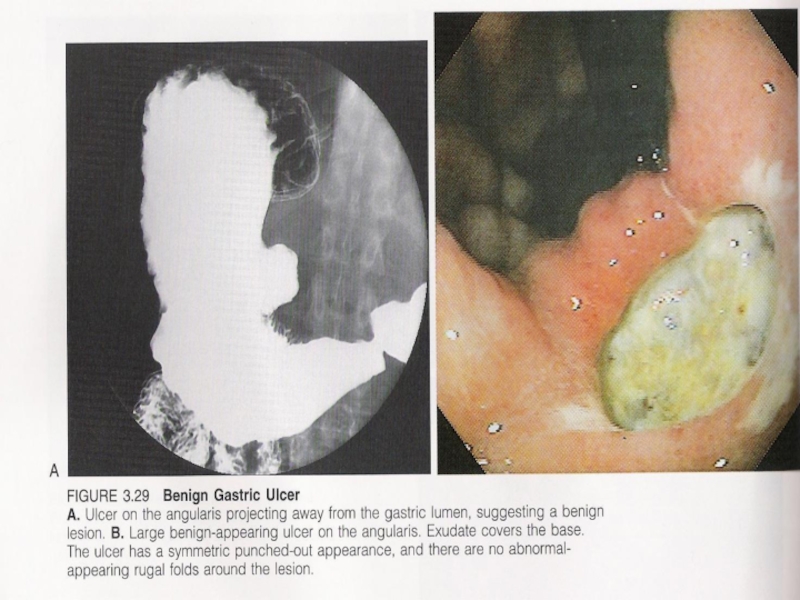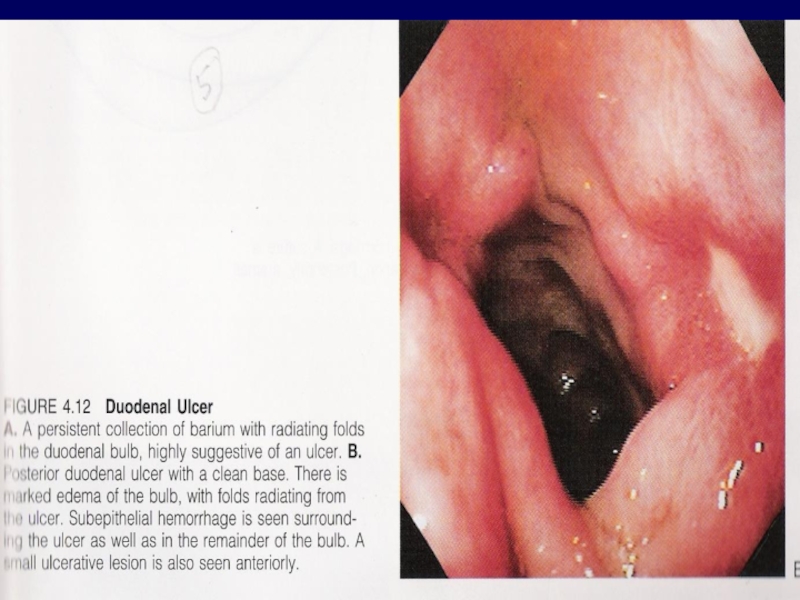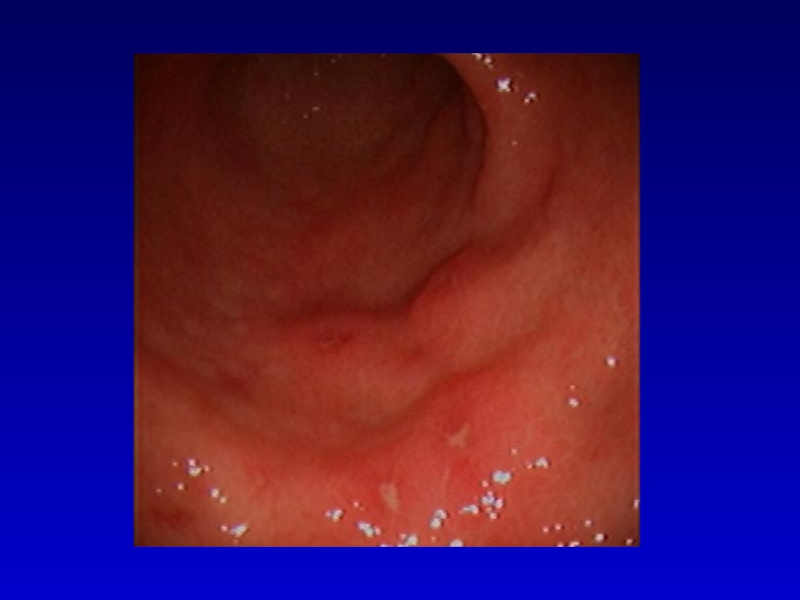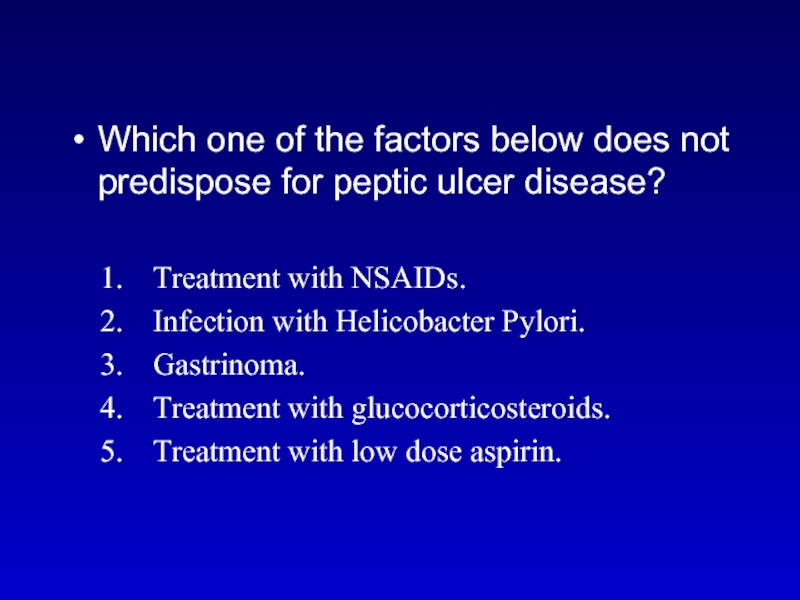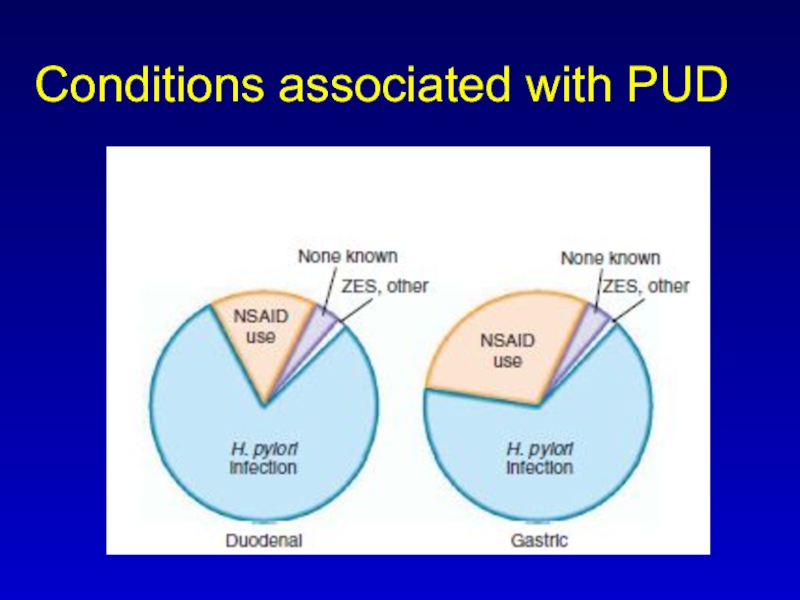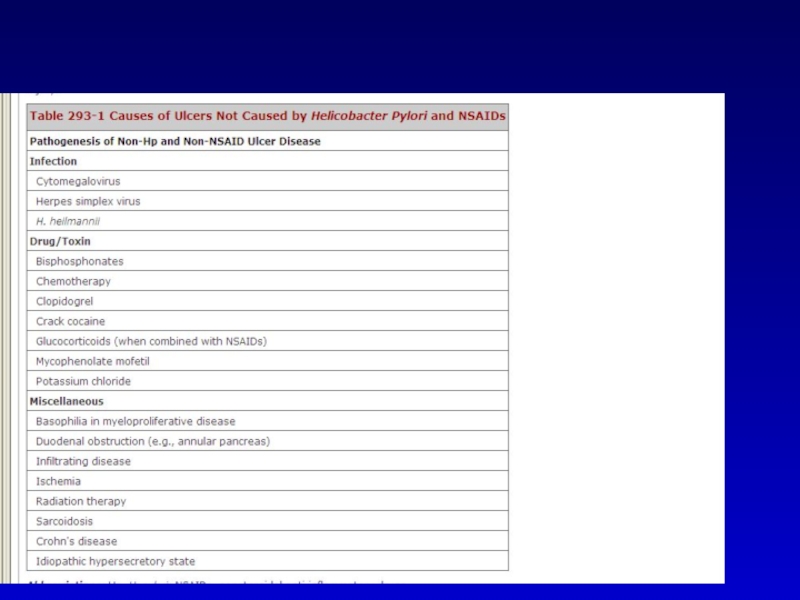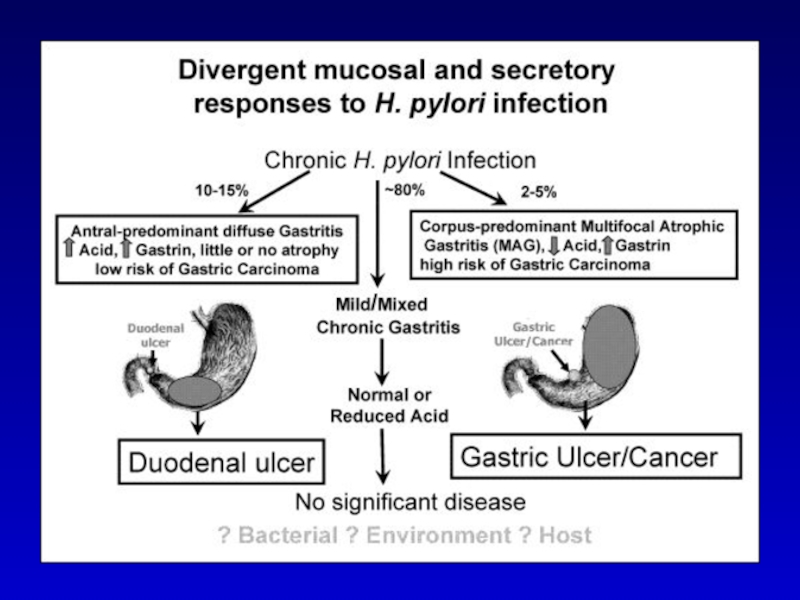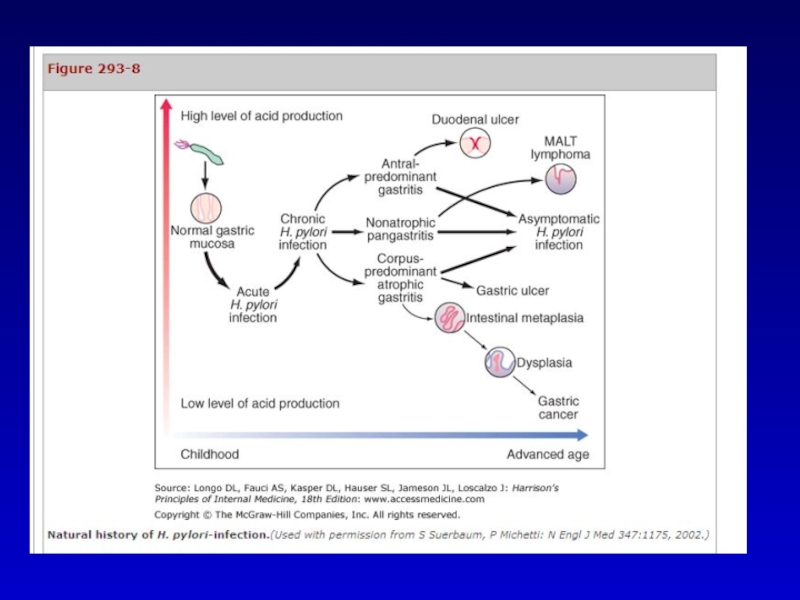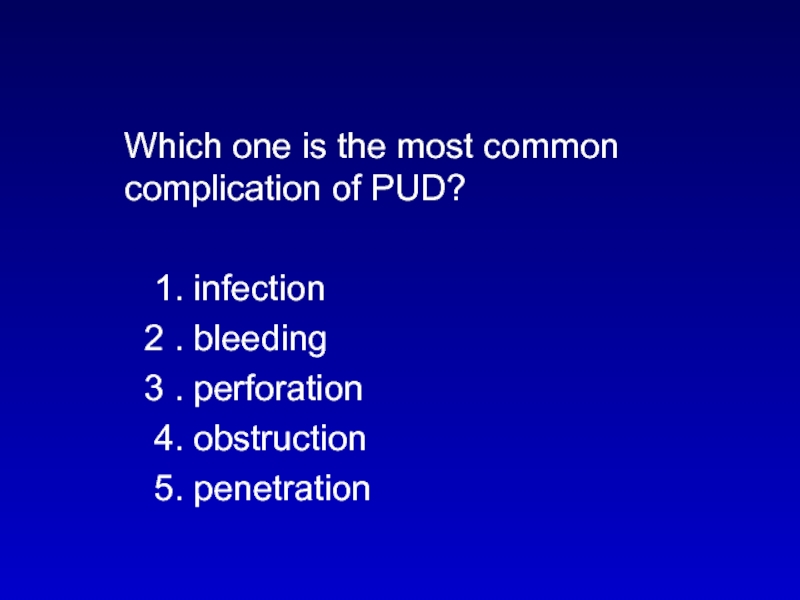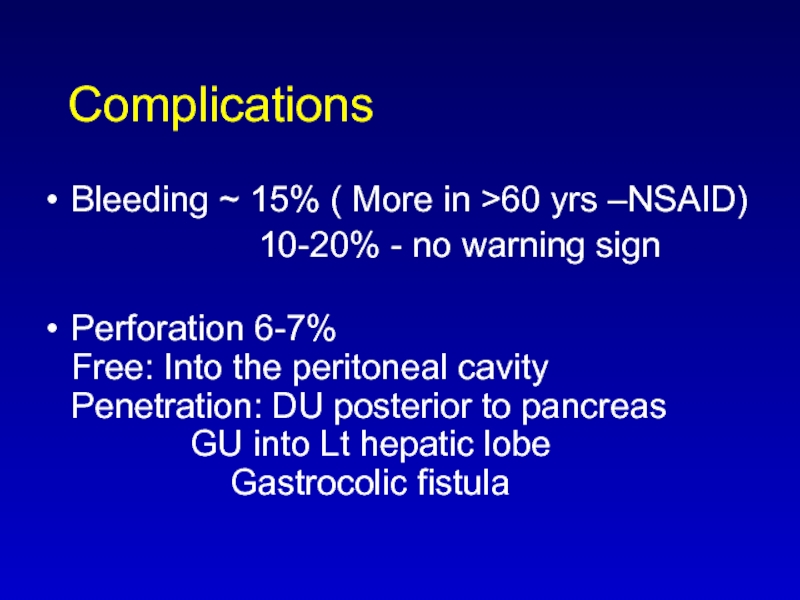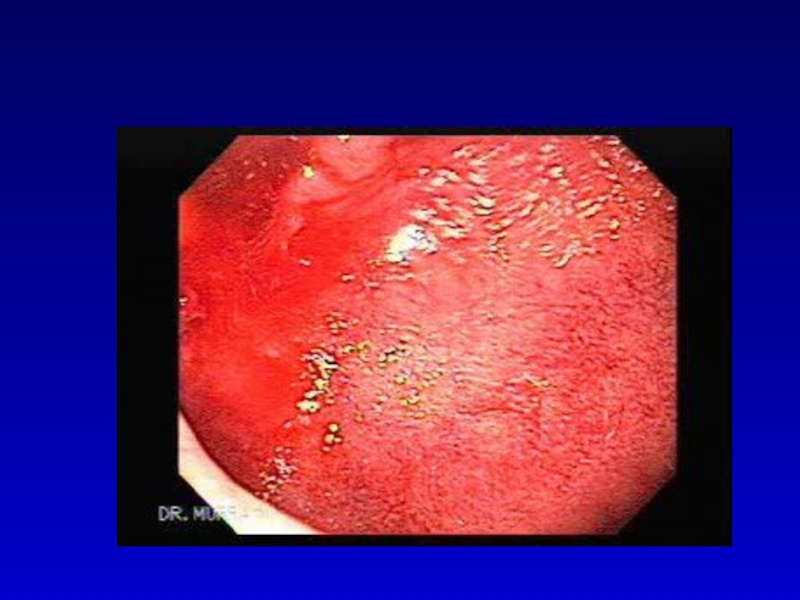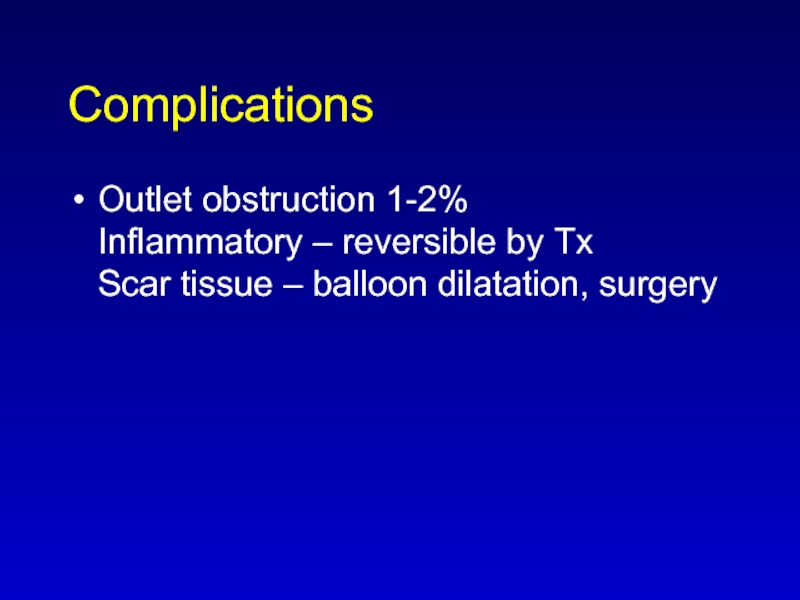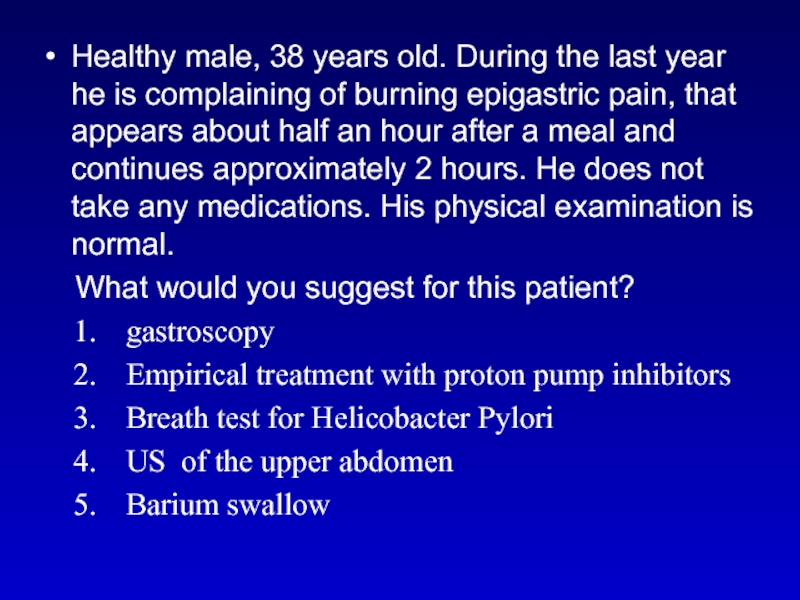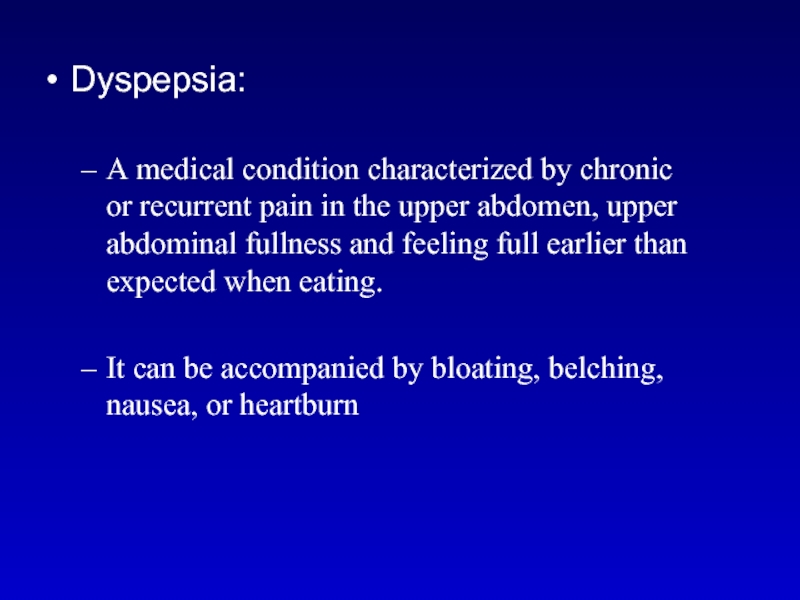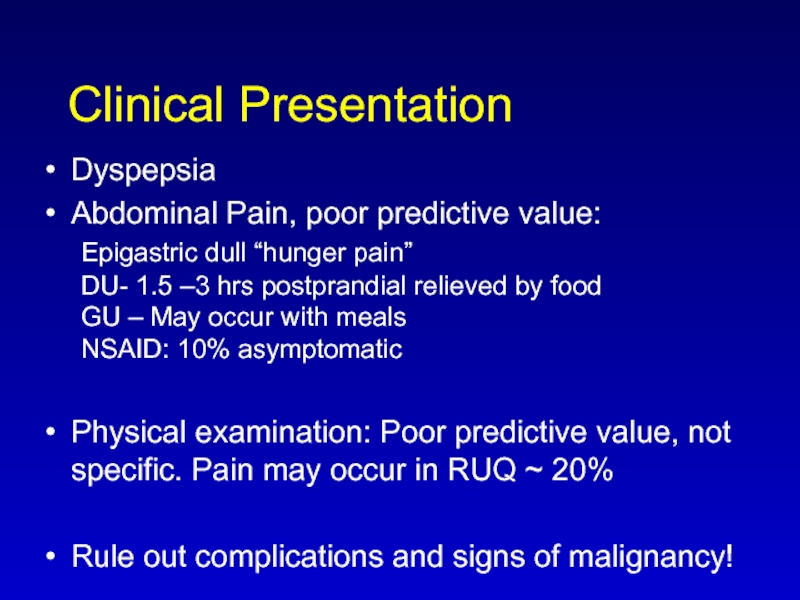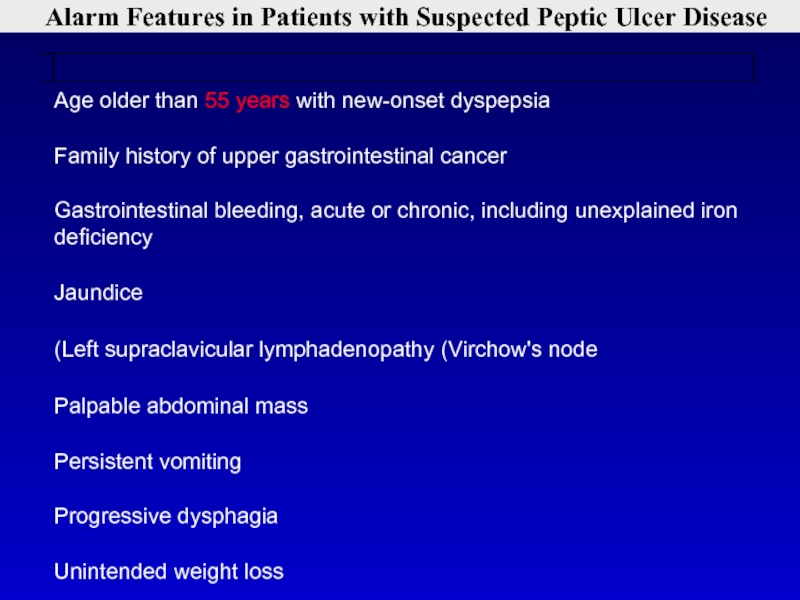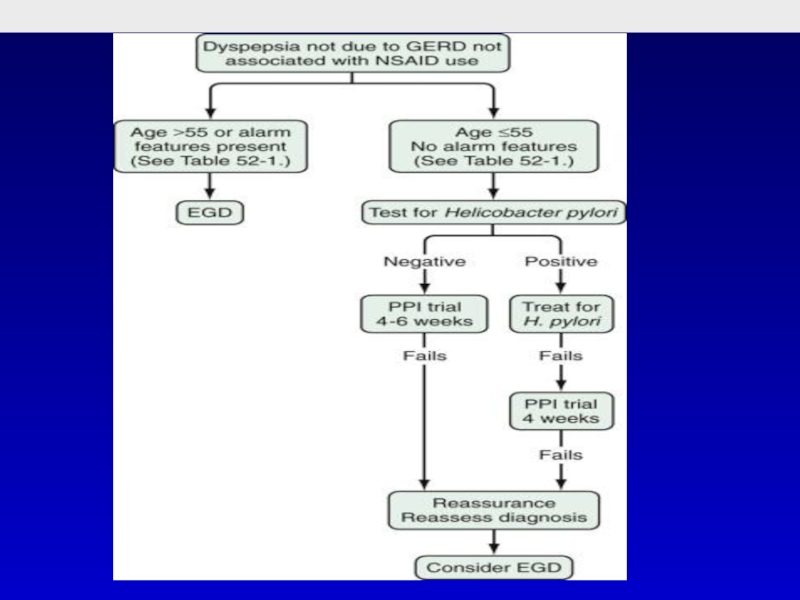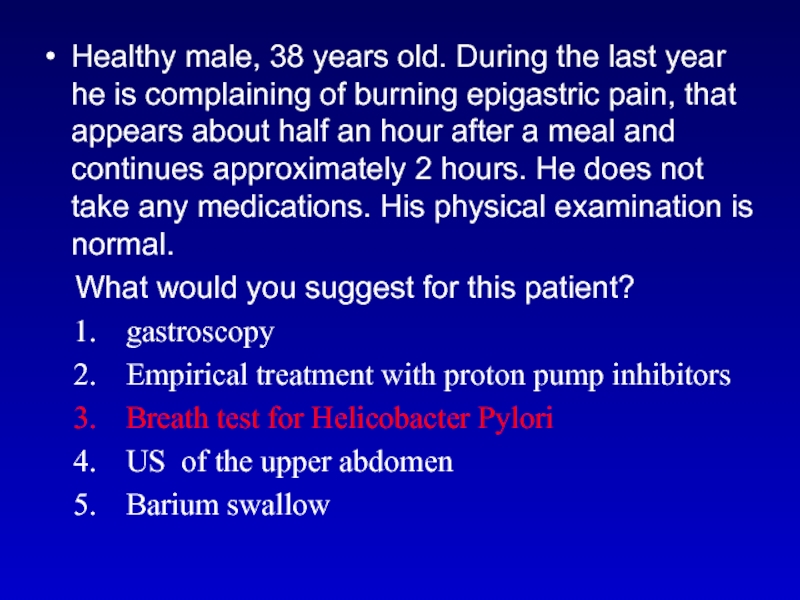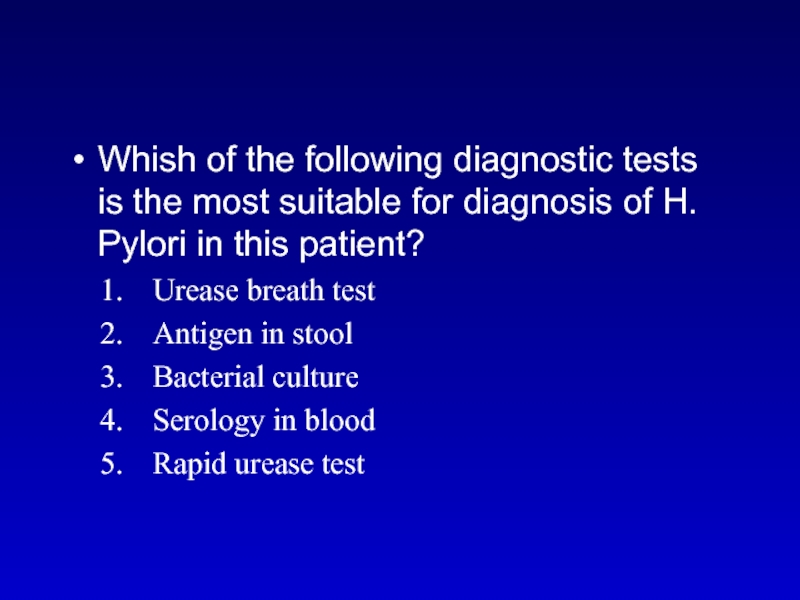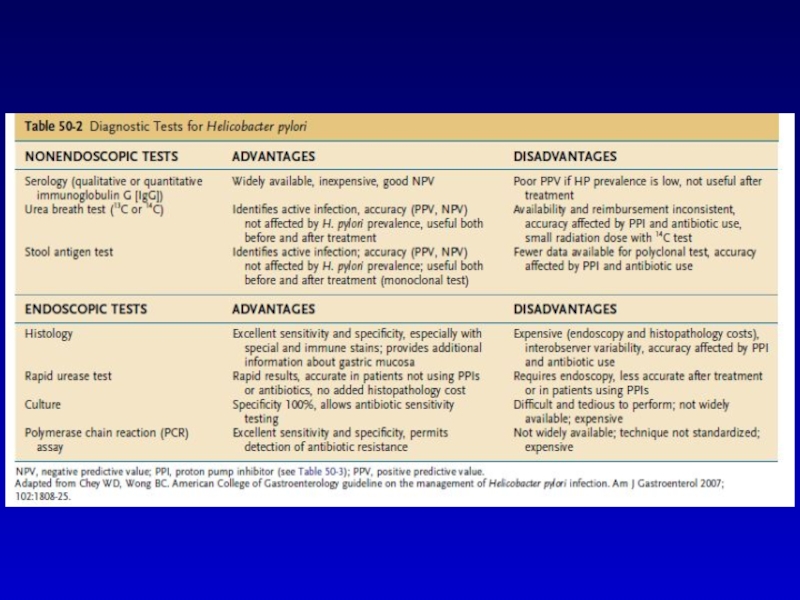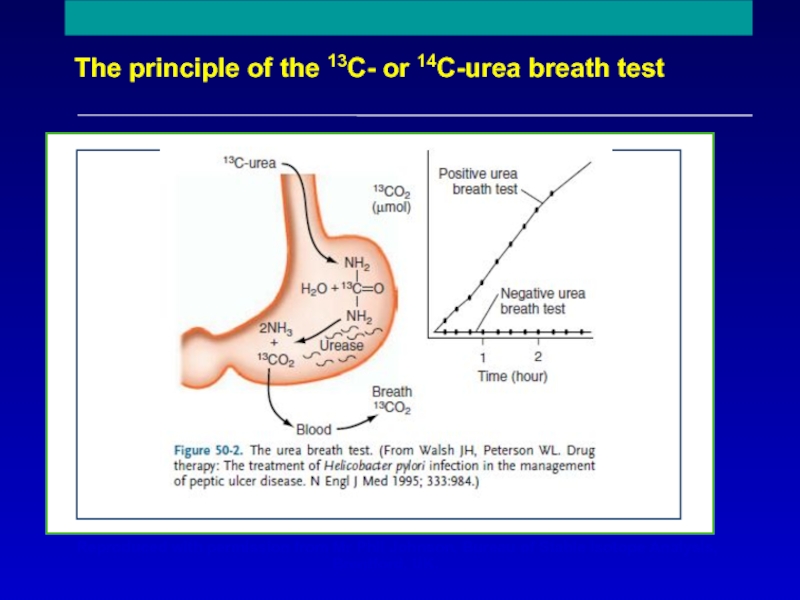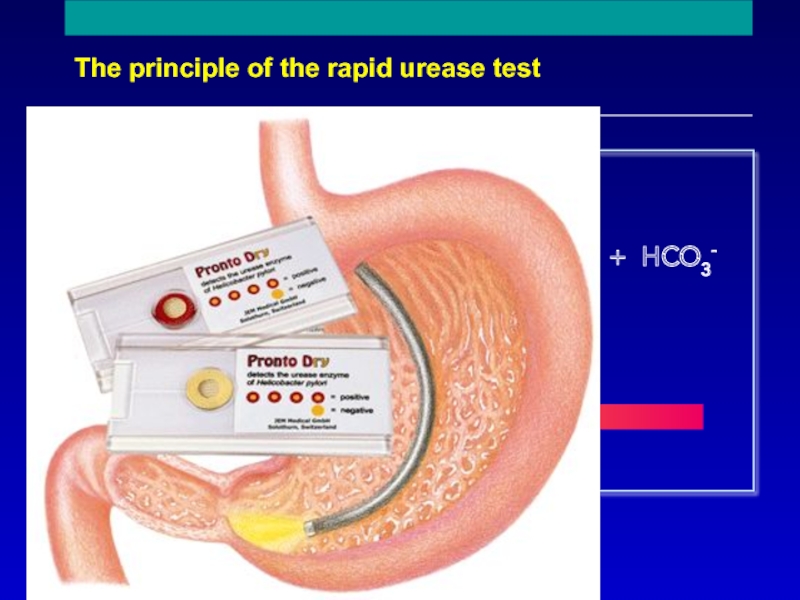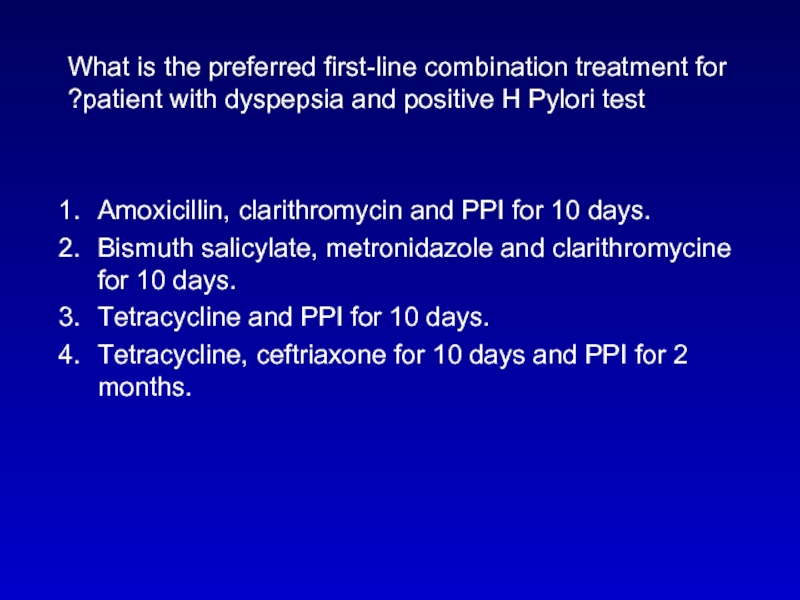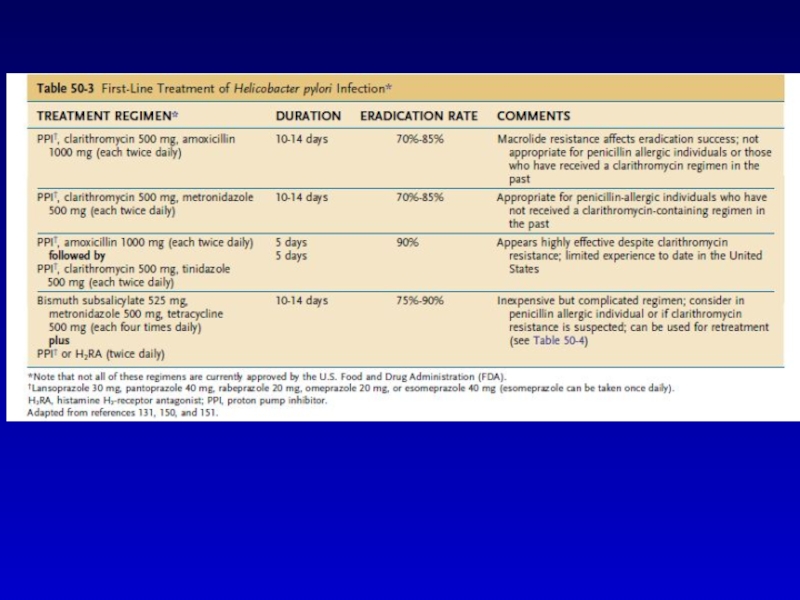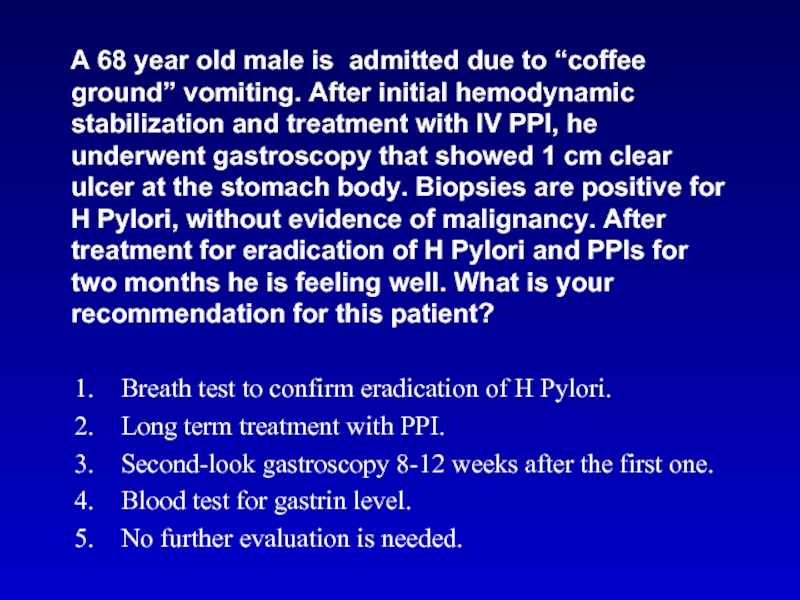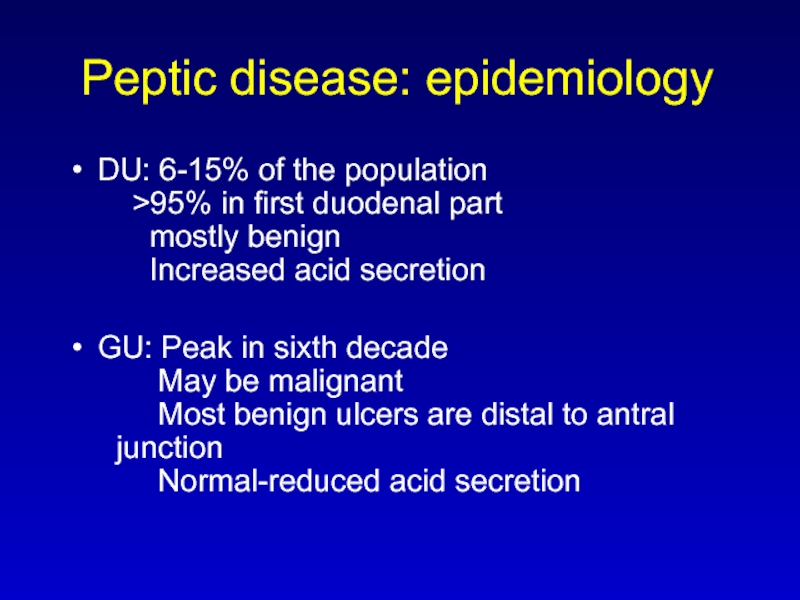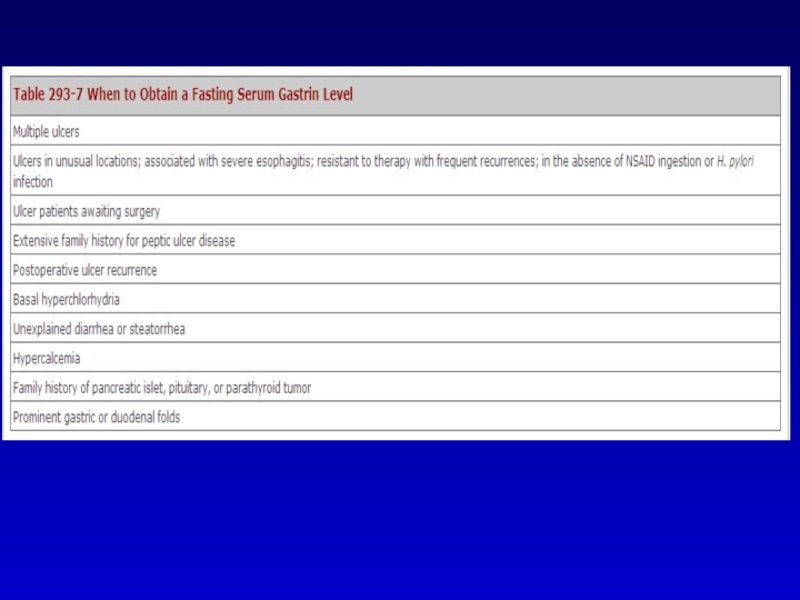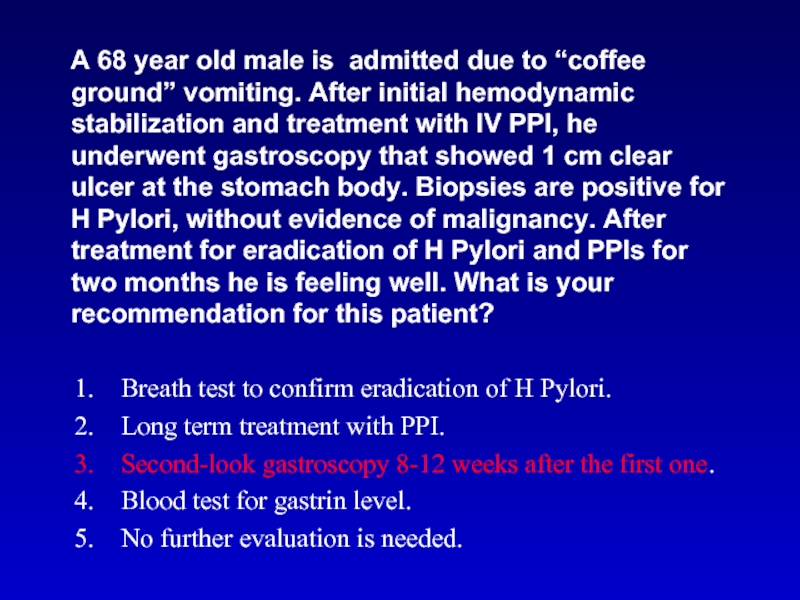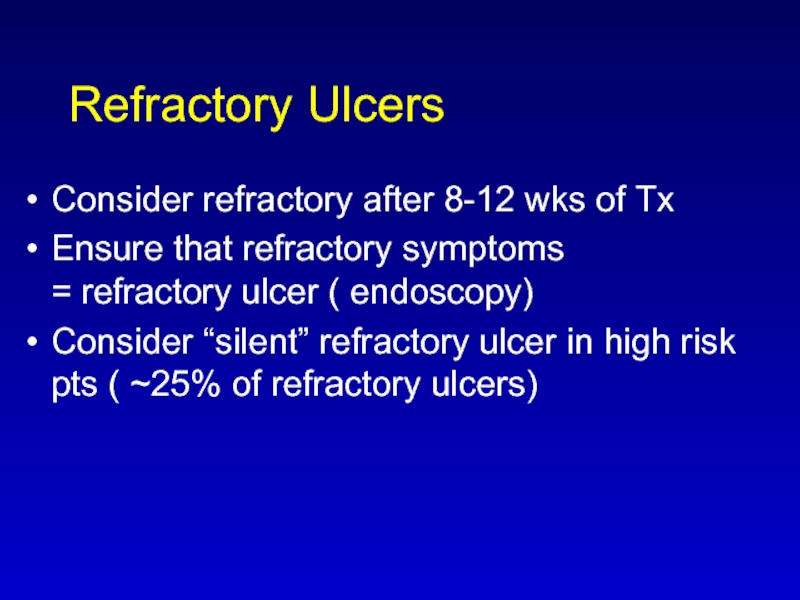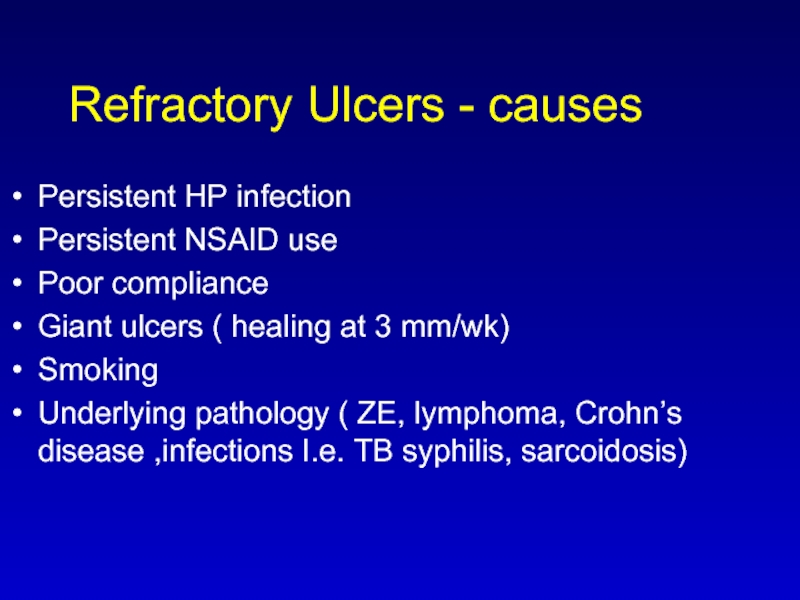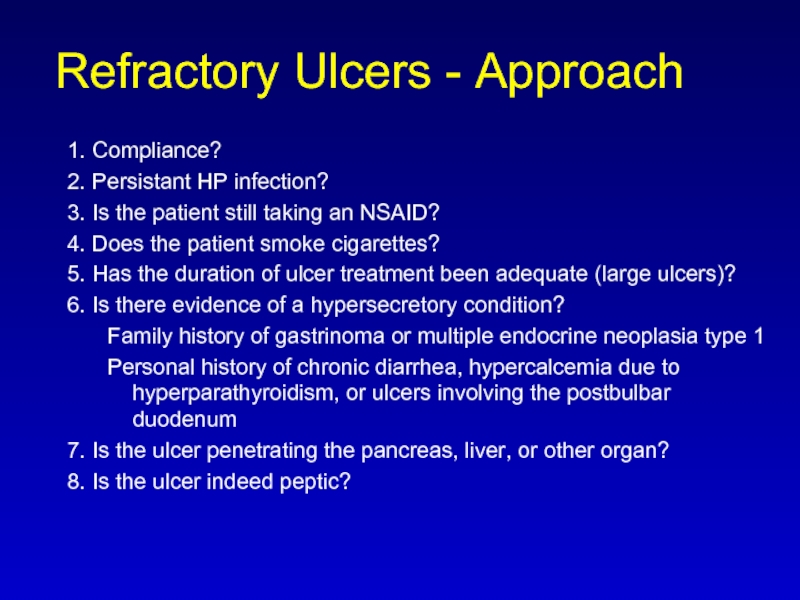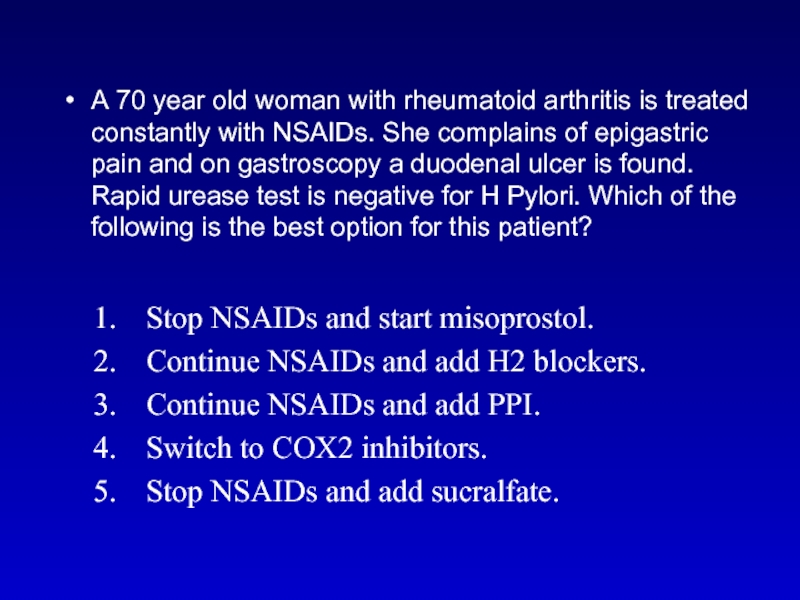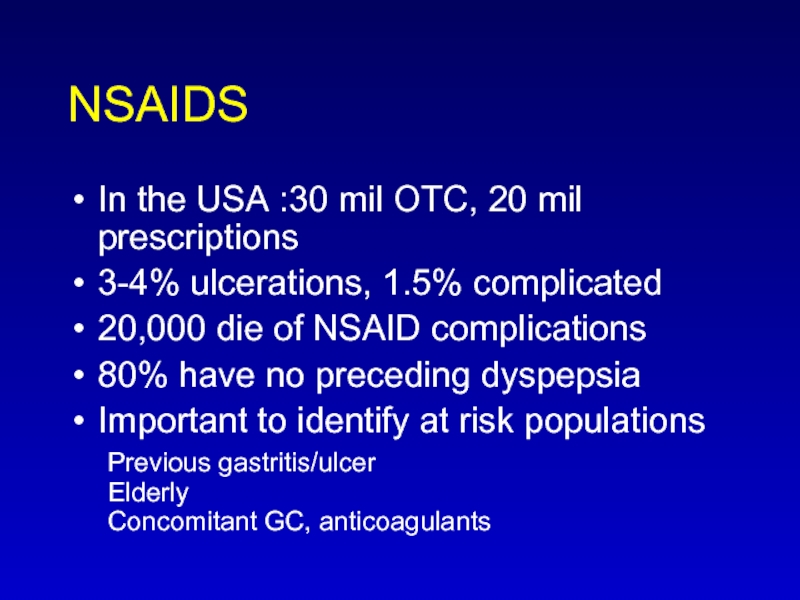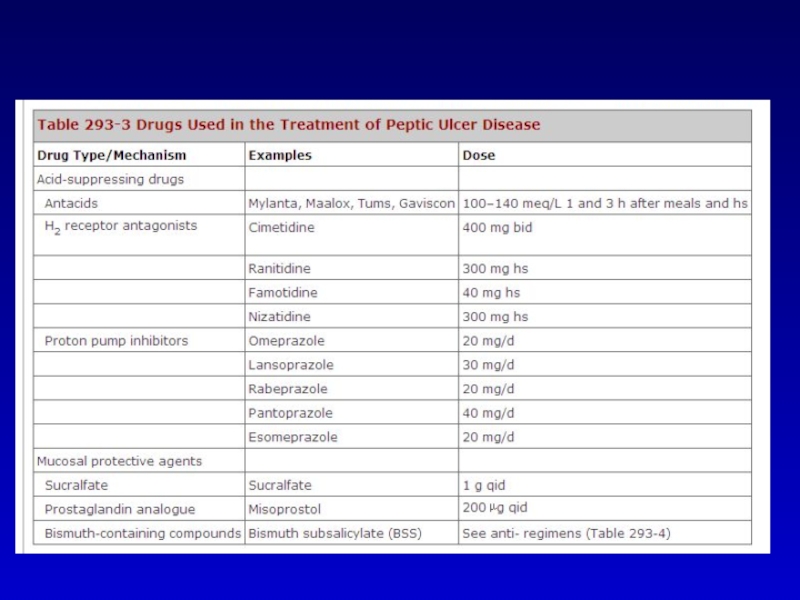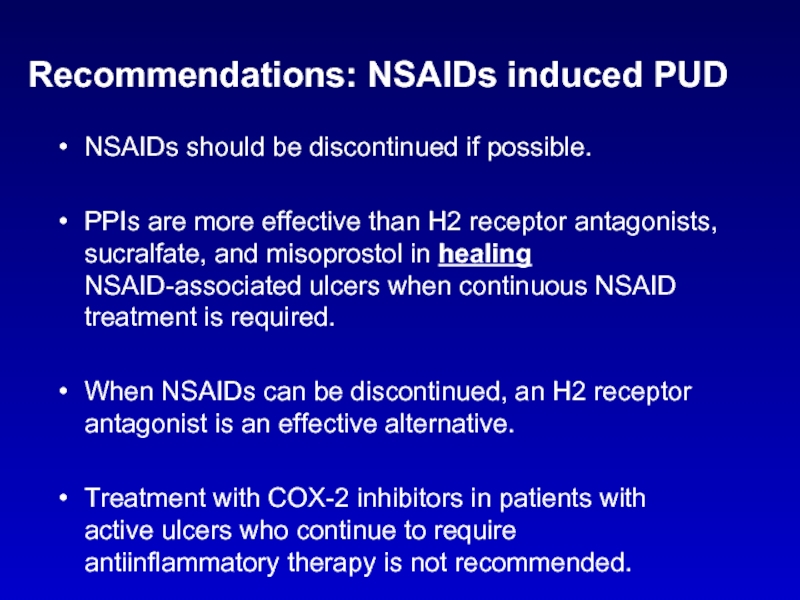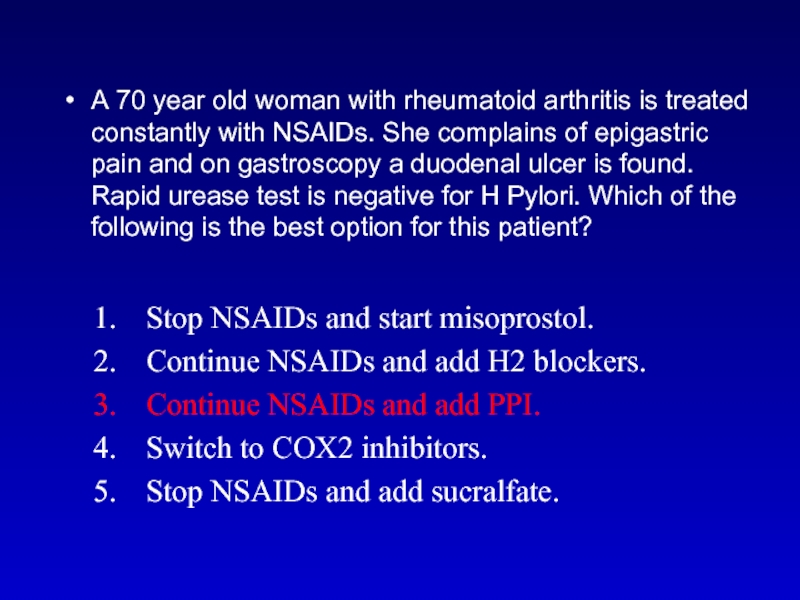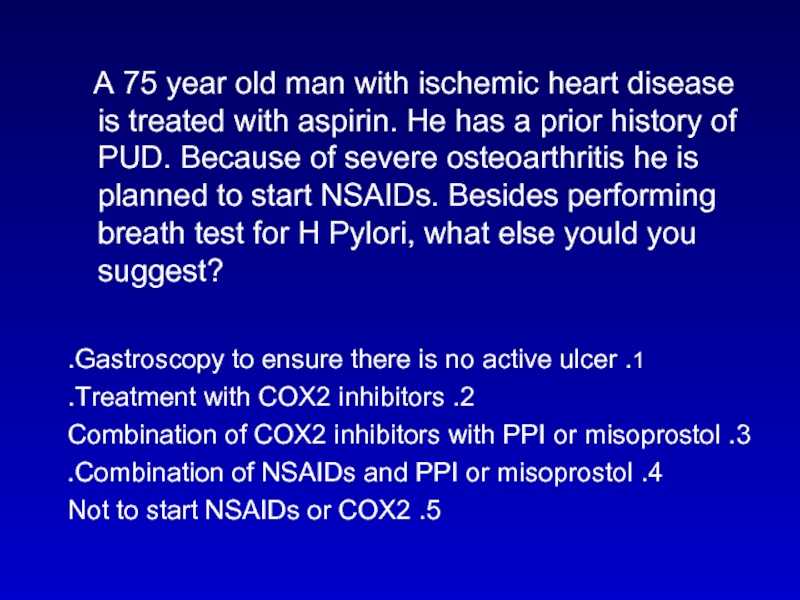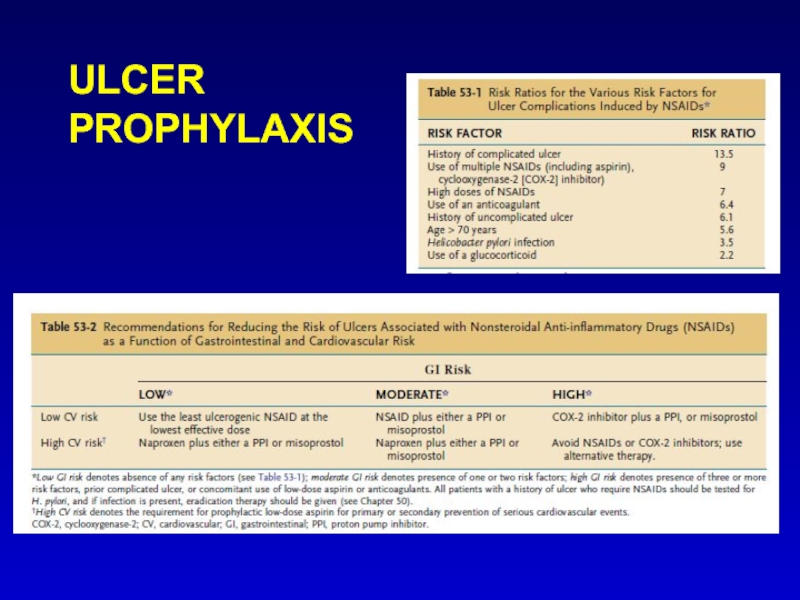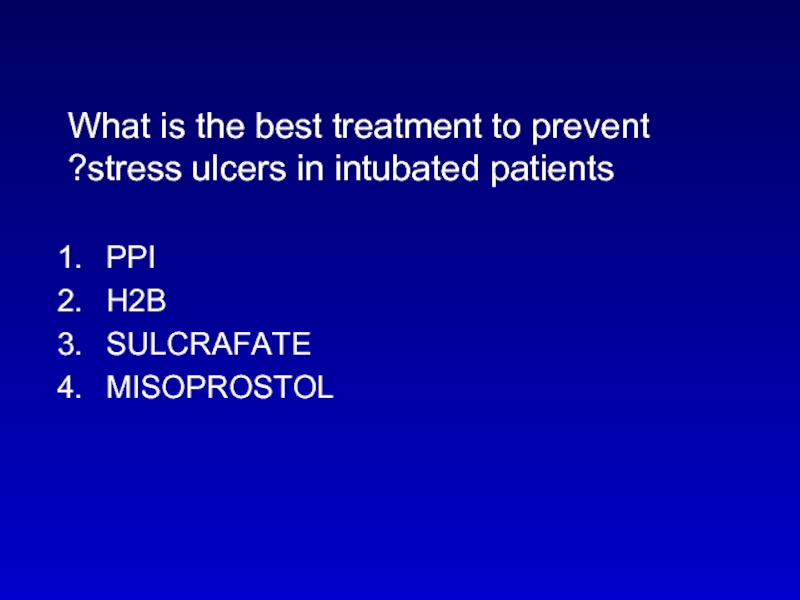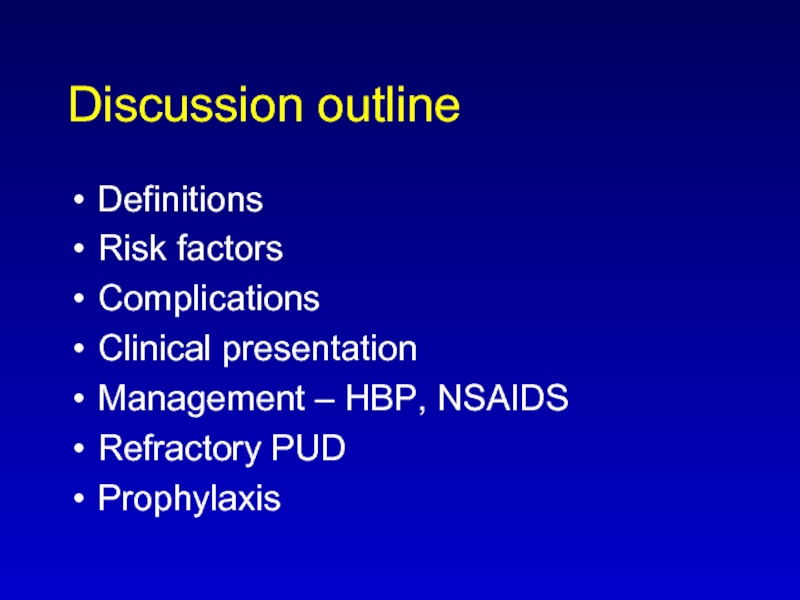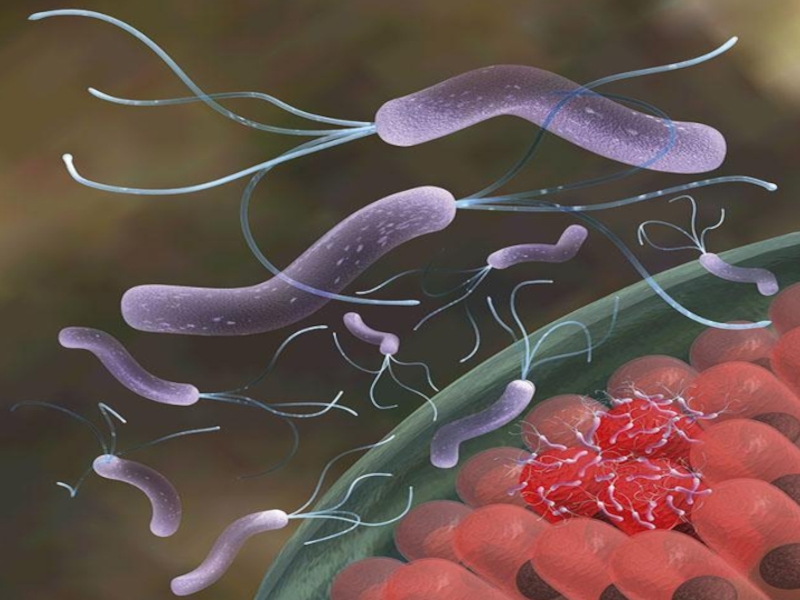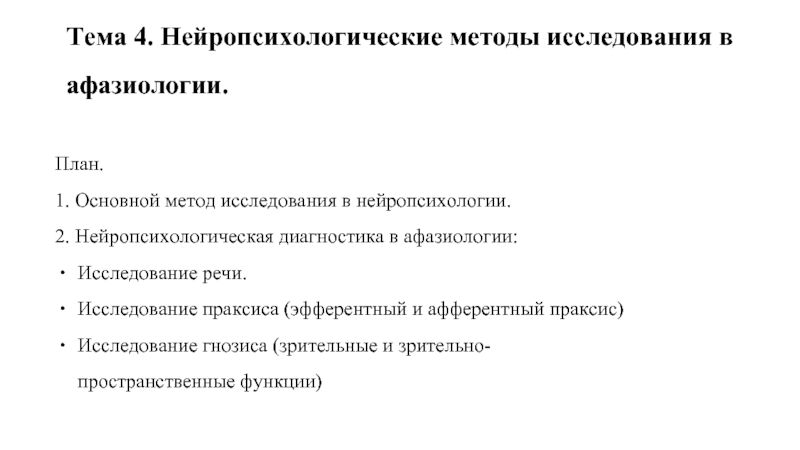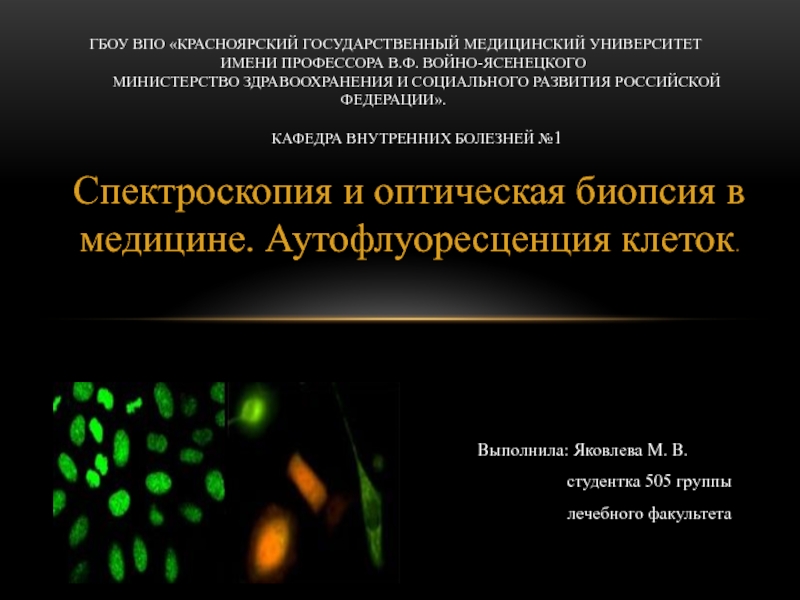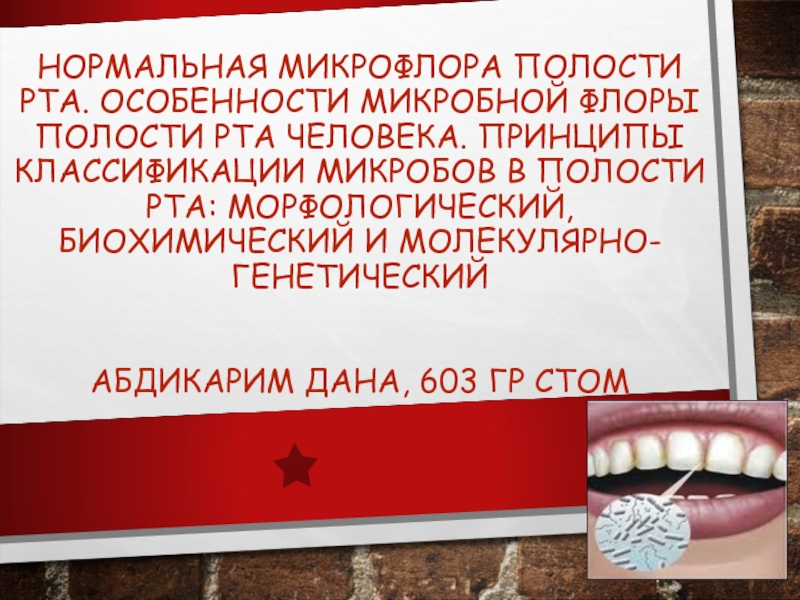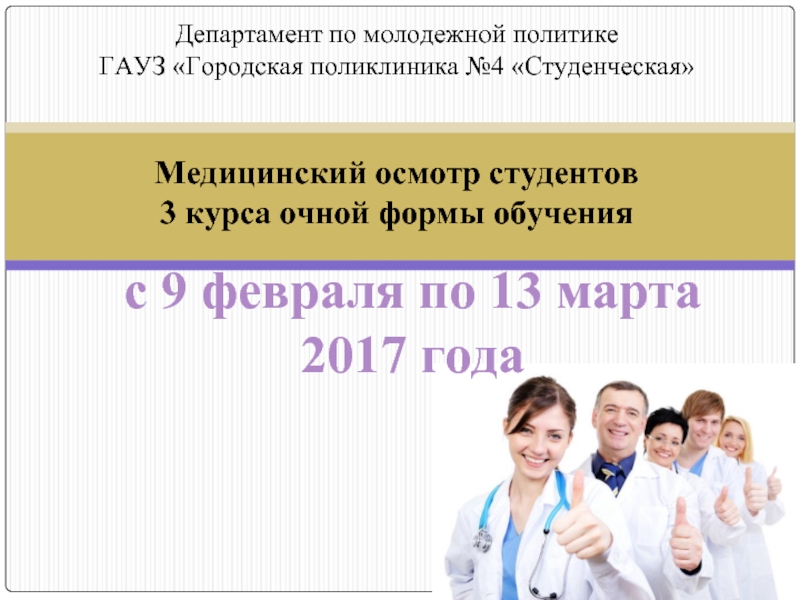- Главная
- Разное
- Дизайн
- Бизнес и предпринимательство
- Аналитика
- Образование
- Развлечения
- Красота и здоровье
- Финансы
- Государство
- Путешествия
- Спорт
- Недвижимость
- Армия
- Графика
- Культурология
- Еда и кулинария
- Лингвистика
- Английский язык
- Астрономия
- Алгебра
- Биология
- География
- Детские презентации
- Информатика
- История
- Литература
- Маркетинг
- Математика
- Медицина
- Менеджмент
- Музыка
- МХК
- Немецкий язык
- ОБЖ
- Обществознание
- Окружающий мир
- Педагогика
- Русский язык
- Технология
- Физика
- Философия
- Химия
- Шаблоны, картинки для презентаций
- Экология
- Экономика
- Юриспруденция
Peptic Ulcer Disease презентация
Содержание
- 1. Peptic Ulcer Disease
- 2. Discussion outline Definitions Risk factors Complications Clinical
- 3. DEFINITION An ulcer in the gastrointestinal (GI)
- 8. Which one of the factors below does
- 9. Conditions associated with PUD
- 13. Which one is the most
- 14. Complications Bleeding ~ 15% ( More in
- 16. Complications Outlet obstruction 1-2% Inflammatory – reversible
- 17. Healthy male, 38 years old. During the
- 18. Dyspepsia: A medical condition characterized by
- 19. Clinical Presentation Dyspepsia Abdominal Pain, poor predictive
- 20. Alarm Features in Patients with Suspected Peptic Ulcer Disease
- 22. Healthy male, 38 years old. During the
- 23. Whish of the following diagnostic tests is
- 25. The principle of the 13C-
- 26. The principle of the rapid urease
- 27. What is the preferred first-line combination treatment
- 29. A 68 year old male
- 30. Peptic disease: epidemiology DU: 6-15% of
- 32. A 68 year old male
- 33. Refractory Ulcers Consider refractory after 8-12 wks
- 34. Refractory Ulcers - causes Persistent HP infection
- 35. Refractory Ulcers - Approach 1. Compliance? 2.
- 36. A 70 year old woman with rheumatoid
- 37. NSAIDS In the USA :30 mil OTC,
- 39. Recommendations: NSAIDs induced PUD NSAIDs should
- 40. A 70 year old woman with rheumatoid
- 41. A 75 year old man
- 42. ULCER PROPHYLAXIS
- 43. What is the best treatment to prevent
- 44. Discussion outline Definitions Risk factors Complications Clinical
Слайд 2Discussion outline
Definitions
Risk factors
Complications
Clinical presentation
Management – HBP, NSAIDS
Refractory PUD
Prophylaxis
Слайд 3DEFINITION
An ulcer in the gastrointestinal (GI) tract may be defined as
a break in the lining of the mucosa, with appreciable depth at endoscopy or histologic evidence of involvement of the submucosa.
Erosions are breaks in the surface epithelium that do not have perceptible depth.
The term peptic ulcer disease is used broadly to include ulcerations and erosions in the stomach and duodenum from a number of causes.
Erosions are breaks in the surface epithelium that do not have perceptible depth.
The term peptic ulcer disease is used broadly to include ulcerations and erosions in the stomach and duodenum from a number of causes.
Слайд 8Which one of the factors below does not predispose for peptic
ulcer disease?
Treatment with NSAIDs.
Infection with Helicobacter Pylori.
Gastrinoma.
Treatment with glucocorticosteroids.
Treatment with low dose aspirin.
Treatment with NSAIDs.
Infection with Helicobacter Pylori.
Gastrinoma.
Treatment with glucocorticosteroids.
Treatment with low dose aspirin.
Слайд 13 Which one is the most common complication of PUD?
1. infection
2 . bleeding
3 . perforation
4. obstruction
5. penetration
2 . bleeding
3 . perforation
4. obstruction
5. penetration
Слайд 14Complications
Bleeding ~ 15% ( More in >60 yrs –NSAID)
10-20% - no warning sign
Perforation 6-7% Free: Into the peritoneal cavity Penetration: DU posterior to pancreas GU into Lt hepatic lobe Gastrocolic fistula
Perforation 6-7% Free: Into the peritoneal cavity Penetration: DU posterior to pancreas GU into Lt hepatic lobe Gastrocolic fistula
Слайд 16Complications
Outlet obstruction 1-2%
Inflammatory – reversible by Tx
Scar tissue – balloon dilatation,
surgery
Слайд 17Healthy male, 38 years old. During the last year he is
complaining of burning epigastric pain, that appears about half an hour after a meal and continues approximately 2 hours. He does not take any medications. His physical examination is normal.
What would you suggest for this patient?
gastroscopy
Empirical treatment with proton pump inhibitors
Breath test for Helicobacter Pylori
US of the upper abdomen
Barium swallow
What would you suggest for this patient?
gastroscopy
Empirical treatment with proton pump inhibitors
Breath test for Helicobacter Pylori
US of the upper abdomen
Barium swallow
Слайд 18Dyspepsia:
A medical condition characterized by chronic or recurrent pain in the
upper abdomen, upper abdominal fullness and feeling full earlier than expected when eating.
It can be accompanied by bloating, belching, nausea, or heartburn
It can be accompanied by bloating, belching, nausea, or heartburn
Слайд 19Clinical Presentation
Dyspepsia
Abdominal Pain, poor predictive value:
Epigastric dull “hunger pain”
DU- 1.5
–3 hrs postprandial relieved by food
GU – May occur with meals
NSAID: 10% asymptomatic
Physical examination: Poor predictive value, not specific. Pain may occur in RUQ ~ 20%
Rule out complications and signs of malignancy!
Physical examination: Poor predictive value, not specific. Pain may occur in RUQ ~ 20%
Rule out complications and signs of malignancy!
Слайд 22Healthy male, 38 years old. During the last year he is
complaining of burning epigastric pain, that appears about half an hour after a meal and continues approximately 2 hours. He does not take any medications. His physical examination is normal.
What would you suggest for this patient?
gastroscopy
Empirical treatment with proton pump inhibitors
Breath test for Helicobacter Pylori
US of the upper abdomen
Barium swallow
What would you suggest for this patient?
gastroscopy
Empirical treatment with proton pump inhibitors
Breath test for Helicobacter Pylori
US of the upper abdomen
Barium swallow
Слайд 23Whish of the following diagnostic tests is the most suitable for
diagnosis of H. Pylori in this patient?
Urease breath test
Antigen in stool
Bacterial culture
Serology in blood
Rapid urease test
Urease breath test
Antigen in stool
Bacterial culture
Serology in blood
Rapid urease test
Слайд 25
The principle of the 13C- or 14C-urea breath test
Reproduced with permission
from Mr Phil Johnson, Bureau of Stable Isotope Analysis,
Brentford, UK.
Слайд 26
The principle of the rapid urease test
NH2
C
NH2
O + 2H2O + H+
2NH4+
+ HCO3-
Urease
Urea
CLOtest
pH change
Слайд 27What is the preferred first-line combination treatment for patient with dyspepsia
and positive H Pylori test?
Amoxicillin, clarithromycin and PPI for 10 days.
Bismuth salicylate, metronidazole and clarithromycine for 10 days.
Tetracycline and PPI for 10 days.
Tetracycline, ceftriaxone for 10 days and PPI for 2 months.
Amoxicillin, clarithromycin and PPI for 10 days.
Bismuth salicylate, metronidazole and clarithromycine for 10 days.
Tetracycline and PPI for 10 days.
Tetracycline, ceftriaxone for 10 days and PPI for 2 months.
Слайд 29 A 68 year old male is admitted due to
“coffee ground” vomiting. After initial hemodynamic stabilization and treatment with IV PPI, he underwent gastroscopy that showed 1 cm clear ulcer at the stomach body. Biopsies are positive for H Pylori, without evidence of malignancy. After treatment for eradication of H Pylori and PPIs for two months he is feeling well. What is your recommendation for this patient?
Breath test to confirm eradication of H Pylori.
Long term treatment with PPI.
Second-look gastroscopy 8-12 weeks after the first one.
Blood test for gastrin level.
No further evaluation is needed.
Breath test to confirm eradication of H Pylori.
Long term treatment with PPI.
Second-look gastroscopy 8-12 weeks after the first one.
Blood test for gastrin level.
No further evaluation is needed.
Слайд 30Peptic disease: epidemiology
DU: 6-15% of the population
>95% in
first duodenal part
mostly benign
Increased acid secretion
GU: Peak in sixth decade May be malignant Most benign ulcers are distal to antral junction Normal-reduced acid secretion
GU: Peak in sixth decade May be malignant Most benign ulcers are distal to antral junction Normal-reduced acid secretion
Слайд 32 A 68 year old male is admitted due to
“coffee ground” vomiting. After initial hemodynamic stabilization and treatment with IV PPI, he underwent gastroscopy that showed 1 cm clear ulcer at the stomach body. Biopsies are positive for H Pylori, without evidence of malignancy. After treatment for eradication of H Pylori and PPIs for two months he is feeling well. What is your recommendation for this patient?
Breath test to confirm eradication of H Pylori.
Long term treatment with PPI.
Second-look gastroscopy 8-12 weeks after the first one.
Blood test for gastrin level.
No further evaluation is needed.
Breath test to confirm eradication of H Pylori.
Long term treatment with PPI.
Second-look gastroscopy 8-12 weeks after the first one.
Blood test for gastrin level.
No further evaluation is needed.
Слайд 33Refractory Ulcers
Consider refractory after 8-12 wks of Tx
Ensure that refractory symptoms
=
refractory ulcer ( endoscopy)
Consider “silent” refractory ulcer in high risk pts ( ~25% of refractory ulcers)
Consider “silent” refractory ulcer in high risk pts ( ~25% of refractory ulcers)
Слайд 34Refractory Ulcers - causes
Persistent HP infection
Persistent NSAID use
Poor compliance
Giant ulcers
( healing at 3 mm/wk)
Smoking
Underlying pathology ( ZE, lymphoma, Crohn’s disease ,infections I.e. TB syphilis, sarcoidosis)
Smoking
Underlying pathology ( ZE, lymphoma, Crohn’s disease ,infections I.e. TB syphilis, sarcoidosis)
Слайд 35Refractory Ulcers - Approach
1. Compliance?
2. Persistant HP infection?
3. Is the
patient still taking an NSAID?
4. Does the patient smoke cigarettes?
5. Has the duration of ulcer treatment been adequate (large ulcers)?
6. Is there evidence of a hypersecretory condition?
Family history of gastrinoma or multiple endocrine neoplasia type 1
Personal history of chronic diarrhea, hypercalcemia due to hyperparathyroidism, or ulcers involving the postbulbar duodenum
7. Is the ulcer penetrating the pancreas, liver, or other organ?
8. Is the ulcer indeed peptic?
4. Does the patient smoke cigarettes?
5. Has the duration of ulcer treatment been adequate (large ulcers)?
6. Is there evidence of a hypersecretory condition?
Family history of gastrinoma or multiple endocrine neoplasia type 1
Personal history of chronic diarrhea, hypercalcemia due to hyperparathyroidism, or ulcers involving the postbulbar duodenum
7. Is the ulcer penetrating the pancreas, liver, or other organ?
8. Is the ulcer indeed peptic?
Слайд 36A 70 year old woman with rheumatoid arthritis is treated constantly
with NSAIDs. She complains of epigastric pain and on gastroscopy a duodenal ulcer is found. Rapid urease test is negative for H Pylori. Which of the following is the best option for this patient?
Stop NSAIDs and start misoprostol.
Continue NSAIDs and add H2 blockers.
Continue NSAIDs and add PPI.
Switch to COX2 inhibitors.
Stop NSAIDs and add sucralfate.
Stop NSAIDs and start misoprostol.
Continue NSAIDs and add H2 blockers.
Continue NSAIDs and add PPI.
Switch to COX2 inhibitors.
Stop NSAIDs and add sucralfate.
Слайд 37NSAIDS
In the USA :30 mil OTC, 20 mil prescriptions
3-4% ulcerations, 1.5%
complicated
20,000 die of NSAID complications
80% have no preceding dyspepsia
Important to identify at risk populations Previous gastritis/ulcer Elderly Concomitant GC, anticoagulants
20,000 die of NSAID complications
80% have no preceding dyspepsia
Important to identify at risk populations Previous gastritis/ulcer Elderly Concomitant GC, anticoagulants
Слайд 39Recommendations: NSAIDs induced PUD
NSAIDs should be discontinued if possible.
PPIs are
more effective than H2 receptor antagonists, sucralfate, and misoprostol in healing NSAID-associated ulcers when continuous NSAID treatment is required.
When NSAIDs can be discontinued, an H2 receptor antagonist is an effective alternative.
Treatment with COX-2 inhibitors in patients with active ulcers who continue to require antiinflammatory therapy is not recommended.
When NSAIDs can be discontinued, an H2 receptor antagonist is an effective alternative.
Treatment with COX-2 inhibitors in patients with active ulcers who continue to require antiinflammatory therapy is not recommended.
Слайд 40A 70 year old woman with rheumatoid arthritis is treated constantly
with NSAIDs. She complains of epigastric pain and on gastroscopy a duodenal ulcer is found. Rapid urease test is negative for H Pylori. Which of the following is the best option for this patient?
Stop NSAIDs and start misoprostol.
Continue NSAIDs and add H2 blockers.
Continue NSAIDs and add PPI.
Switch to COX2 inhibitors.
Stop NSAIDs and add sucralfate.
Stop NSAIDs and start misoprostol.
Continue NSAIDs and add H2 blockers.
Continue NSAIDs and add PPI.
Switch to COX2 inhibitors.
Stop NSAIDs and add sucralfate.
Слайд 41 A 75 year old man with ischemic heart disease
is treated with aspirin. He has a prior history of PUD. Because of severe osteoarthritis he is planned to start NSAIDs. Besides performing breath test for H Pylori, what else yould you suggest?
1. Gastroscopy to ensure there is no active ulcer.
2. Treatment with COX2 inhibitors.
3. Combination of COX2 inhibitors with PPI or misoprostol
4. Combination of NSAIDs and PPI or misoprostol.
5. Not to start NSAIDs or COX2
1. Gastroscopy to ensure there is no active ulcer.
2. Treatment with COX2 inhibitors.
3. Combination of COX2 inhibitors with PPI or misoprostol
4. Combination of NSAIDs and PPI or misoprostol.
5. Not to start NSAIDs or COX2
Слайд 43What is the best treatment to prevent stress ulcers in intubated
patients?
PPI
H2B
SULCRAFATE
MISOPROSTOL
PPI
H2B
SULCRAFATE
MISOPROSTOL
